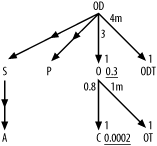1.4 A Bonus
The method this book describes reduces a query to an abstract representation that contains only the information relevant to tuning.
|
This is akin to reducing an elaborate word problem in high-school mathematics to a simple, abstract equation, where the solution of the equation is generally almost automatic once you know the necessary math. The abstract representation of a SQL tuning problem, the query diagram, normally takes the form of an upside-down tree, with some numbers attached, as shown in Figure 1-1.
Figure 1-1. An example of a query diagram

As it turns out, SQL is such a flexible language that it is capable of producing queries that do not map to the usual tree form, but it turns out that such queries almost never make sense from a business perspective. This delivers an unplanned-for side benefit: in the course of tuning SQL and producing the abstract query representations that aid you in that process, certain problems with the logic of the queries become obvious, even if you have no prior knowledge of the application. Developers usually catch these problems before you see the SQL, unless the problems lie in the sort of corner cases that they might not test thoroughly, as these problems often do. These corner-case problems can be the worst kind for an applicationfor example, throwing accounts out of balance long after the application goes live and is assumed to be fine, in subtle ways that are hard to detect and hard to fix.
|
Sometimes, fixing a performance problem also requires you to fix a logic problem. Even when the problems are independent (when you can fix performance without fixing the logic flaw), you can perform a major added service by identifying these logic flaws and seeing that they are fixed. This book covers these logic flaws at length, including detailed descriptions of how to find each one and what to do about it. I go so far as to recommend you take any significantly complex, manually written SQL through the SQL diagramming exercise just to find these subtle logic errors, even if you already know that it performs well. Depending on the tool, some products that autogenerate SQL avoid most of these problems.







